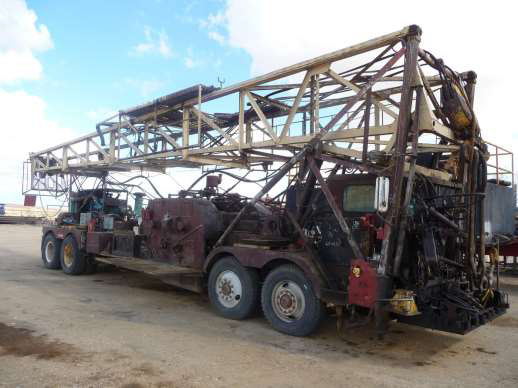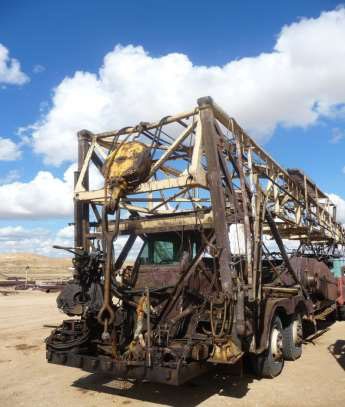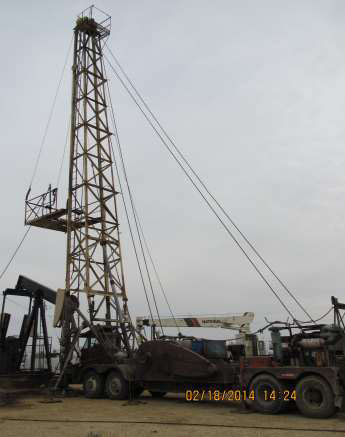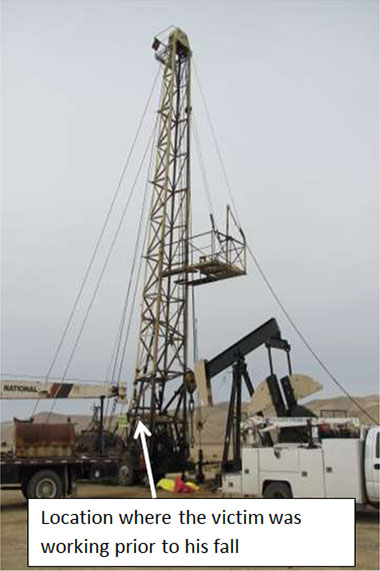Case Report: 14CA001
Floor hand dies when he falls off a mobile oil well servicing rig
Download a PDF to print this report:
Floor hand dies when he falls off a mobile oil well servicing rig (14CA001, PDF)
Summary
A floorhand died when he fell approximately eight feet off a mobile oil well servicing rig to the ground below. The work crew was in the process of shutting down the operation when the incident occurred. The victim was standing on the metal guard above the cab of the rig, preparing to secure the equipment. The cab guard was not equipped with guardrails and the victim was wearing a hard hat and fall protection equipment, however the fall protection was not attached to the rig. Autopsy toxicology studies showed the presence of methamphetamine in the victim's urine. The CA/FACE investigator determined that, in order to prevent future incidents, well servicing companies should ensure that:
- Employees utilize a personal fall restraint system when working six feet above a work floor, ground, or other working surface.
- Mobile oil well servicing rigs are equipped with fall restraint tie-off points at employee working positions.
In addition, well servicing companies:
- may consider implementing an appropriate drug testing program.
Introduction
On Tuesday, February 18, 2014, at 10:30 a.m., a 53-year-old male floorhand died when he fell off a mobile oil well servicing rig. The CA/FACE investigator received notification of this incident on February 20, 2014, from the Bureau of Investigations of the Division of Occupational Safety and Health (Cal/OSHA). The employer was contacted by the CA/FACE investigator on February 25, 2014. On March 6, 2014, the CA/FACE investigator and an industrial hygienist from the California Department of Public Health, Occupational Health Branch, visited the incident site. Interviews were conducted with the company owner and crew onsite the day of the incident. Pictures of the mobile oil well servicing rig and worksite were taken.
Employer
The employer of the victim was a drilling contractor, oil developer, and producer that had been in business for over 40 years and had six employees.
Written Safety Programs and Training
The company had a written safety policy and an injury and illness prevention program (IIPP) that contained all the required elements. The victim and other employees received health and safety training from safety equipment manufacturers and from a safety consultant on request.
The Victim
The victim was a 53-year-old male floorhand who had worked for this company for three years, and had been in oil field work since 1981. A floorhand assists other members of the service rig crew, including set-up and dismantling.
Investigation
On the day of the incident, the victim, the owner of the company, and another worker were working off a mobile well servicing rig. The rig was over 50 years old. The rig was utilized to replace the pump at an oil well in an open desert area. The maintenance service on that oil well was complete and the crew had begun the process of unhooking the block of the mobile well servicing rig from the oil well. The co-worker was on the driver side of the rig, gathering and cleaning tools and putting them away. The owner of the company was on the passenger side of the rig, disconnecting and securing various parts. The victim climbed on top of the cab deck to secure the block before lowering the lattice boom. The cab deck measured approximately eight feet wide by five feet long and was about eight feet above the ground. The deck was designed without guardrails, as this interfered with the lattice boom in the transport position. The co-worker put some tools away and was walking to the front of the rig when he witnessed the victim falling off the deck. The owner also witnessed the victim fall to the ground and immediately called 911. According to these witnesses, the victim fell straight to the ground without hitting the rig. The victim was wearing a hard hat and a full-body harness with attached lanyard, however he never attached the lanyard. Emergency responders pronounced the victim dead at the scene. According to the company owner, the victim was wearing a hydrogen sulfide monitor. There was no evidence of elevated hydrogen sulfide levels at the time of the victim's death.
Cause of Death
The cause of death according to the death certificate was severe blunt injuries of head and neck. The victim had severe atherosclerotic heart disease. Toxicology was positive for methamphetamines.
Recommendations
The CA/FACE investigator determined that, in order to prevent future incidents, well servicing companies should ensure that:
Recommendation #1: Employees utilize a personal fall restraint system when working six feet above a work floor, ground, or other working surface.
Discussion: In this incident, the victim was standing on the deck of the cab, approximately eight feet above ground level, and did not attach his personal fall restraint system. A fall from more than six feet can result in severe injury including fracture, internal bleeding, and possible death from spinal injury. The California Petroleum Safety Orders require that a safety belt and lanyard be used as a restraining system for each employee working on a derrick or mast at a height more than ten feet (10') above the derrick, mast floor, or ground level. Federal OSHA requires fall protection for any height greater than six feet for most industries. Severe injury can occur if an employee falls from a height of greater than six feet. This system consists of anchorages, connectors, and a body belt or full body harness. Had the victim in this incident attached his personal fall restraint system to an anchor point, the fall may have been prevented.
Recommendation #2: Mobile oil well servicing rigs are equipped with fall restraint tie-off points at employee working positions.
Discussion: In this incident, the victim was standing on a deck without guardrails, as this would interfere with the boom position during travel. As an older piece of equipment, the deck of this rig was not designed with tie-off points or anchors that allowed for a fall restraint system. Some newer mobile oil well servicing rigs are designed with features that can be used for this purpose. Alternatively, the deck could be retrofitted with anchor points. Although the victim and likely many other employees had worked off this deck many times in the past without incident, the risk of severe injury from a fall was nonetheless present. Had the employer ensured that this mobile rig had anchors for a fall restraint system, the victim may have tied off and prevented his fall.
In addition, well servicing companies:
Recommendation #3: May consider implementing an appropriate drug testing program.
Discussion: In this case, the post-mortem toxicology report was positive for methamphetamines. Although it is not clear if methamphetamines played a role in this fatality, their use can result in neurological impairment including poor judgment and impaired motor control. Employees using drugs that cause these health effects may jeopardize themselves and others when they are operating heavy equipment or working from heights. Methamphetamines may also cause rapid heartbeat, and may lead to impaired heart function especially with underlying atherosclerosis. The victim had severe atherosclerosis, and the use of methamphetamines may have triggered a cardiac event that led to his fall. Evidence suggests that employees in the oil and gas industry may have higher rates of drug use. The employer in this incident did not provide a program to ensure that employees who work at heights or with dangerous equipment are free from drugs that could endanger themselves or others. Employers implementing applicant or employee drug testing programs should develop and communicate clear policies that are permissible under the law; legal consultation is recommended. Had the victim been part of such a program, the risk of methamphetamines contributing to his death may have been minimized.
Exhibits

Exhibit 1. The mobile oil well servicing rig involved in the incident.

Exhibit 2. The front of the rig involved in this incident.

Exhibit 3. The rig at the incident scene with the boom extended.

Exhibit 4. The location where the victim fell from.
References
Division of Occupational Safety and Health - Title 8 regulations
Subchapter 14. Petroleum Safety Orders--Drilling and Production
Article 3. Injury and Illness Prevention Program
§6507. Injury and Illness Prevention Program.
§6508. Accident Prevention Program.
Article 22. Safety Belts and Lanyards
§6580. Safety Belts and Lanyards.
Employee Drug Testing Pros and Cons - Small Business Chronicle article
Drug Testing in the Workplace - Texas Workforce Commission recommendation
Authors
Hank Cierpich, FACE Investigator
Robert Harrison, MD, MPH, FACE Project Officer
Laura Styles, MPH, Research Scientist
Tracy Barreau, REHS, Industrial Hygienist
April 21, 2015 (Revised May 15, 2015)